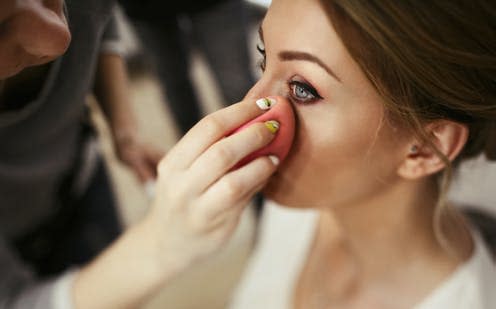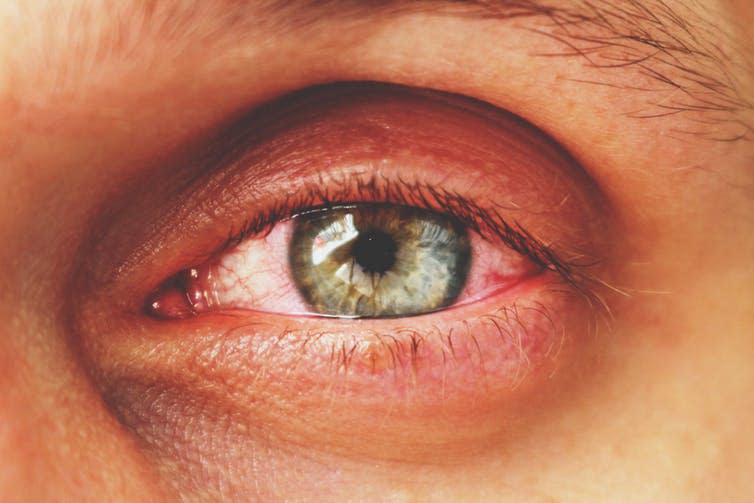Deadly bugs found in nine out of ten makeup bags

We recently tested 467 makeup products, donated by people in the UK, for bacterial and fungal contamination and found that 90% contained potentially deadly germs. These products, which included lipstick and mascara, could pose a significant health threat.
We found E coli and Staphylococci in used eyeliner and mascara. These bacteria can cause irritation and conjunctivitis (pink eye). Although the symptoms of conjunctivitis tend to be mild – itchy, watery eyes – in extreme cases it can lead to sight loss. And the germs causing conjunctivitis can spread to other parts of the body, which can trigger a more serious secondary infection.
The lipsticks and lip gloss in our sample contained Staphylococci and various bacteria associated with faecal matter. These bacteria could cause redness, swelling and inflammation of the lips, which can be treated with antibiotics or antibacterial creams. But if the germs spread to the blood or deeper tissues of the body, the infection can become life threatening.
Also, some strains of Staphylococci, such as Staphylococcus aureus, have become more resistant to antibiotics. S aureus is fairly contagious and can cause skin infections, including impetigo.
The makeup products we examined (lipstick, lip gloss, eyeliners, mascaras and beauty blenders) had between 100 and 1,000 individual bacteria, except for beauty blenders which had an average of a million bacteria. As few as 100 cells of some bacteria can cause infection.

Beware the beauty blender
Previous studies have investigated microbial contamination in makeup in other countries, such as Iran, Saudi Arabia and Italy,. They have reported high levels of disease-causing bacteria, including E coli, Salmonella, Klebsiella and Citrobacter, but little research has been conducted in the UK.
Our research is the first to look at beauty blenders – a popular foundation blending and contouring sponge. (Over 6.5m beauty blenders have been sold worldwide.)
We found that these products are particularly susceptible to contamination as they are often left damp after use, which creates an ideal breeding ground for harmful bacteria. Most (93%) of the beauty blenders we tested had never been cleaned, despite two-thirds (64%) of those we surveyed admitting that they’d dropped them on the floor.
It’s actually easy to avoid germs from cosmetics. Beauty blenders can be cleaned with warm, soapy water. For lipstick, simply turn the lipstick tube up slightly and wipe off the top layer of lipstick with a tissue, then pour a small amount of rubbing alcohol and dip the exposed lipstick into the alcohol for 30 seconds. Remove it and gently dab the alcohol off and allow it to dry. This won’t affect the lipstick but will keep it clean.
Mascara pots can harbour bacteria, but they can’t be cleaned, so it’s best to replace your mascara monthly or use disposable wands.
Check expiry dates
All cosmetics are made under strict conditions to control the growth and accumulation of microbes during use. Preservatives are used to stop bacteria from growing, but they have a finite shelf life. All cosmetics have expiry dates, which are calculated based on the length of time the preservatives in the product are able to control contamination.
If the expiry date is printed on the packaging, it is displayed in the form of a symbol resembling an opened pot with either 3M, 6M, 12M, 18M, 24M, or 36M printed in the middle, corresponding to the number of months the product can be used. Most products have an expiry date of three to 12 months, providing the user has not had an infection, such as conjunctivitis. However, our latest study shows that people are using products beyond the expiry dates and allowing microbial contamination to build up.
To avoid contamination, make sure you discard makeup that has passed the expiry period, don’t apply makeup if you have an infection or broken skin, never share cosmetics with friends, and definitely avoid using makeup samples in stores.
This article is republished from The Conversation under a Creative Commons license. Read the original article.

Amreen Bashir does not work for, consult, own shares in or receive funding from any company or organisation that would benefit from this article, and has disclosed no relevant affiliations beyond their academic appointment.

 Yahoo News
Yahoo News 